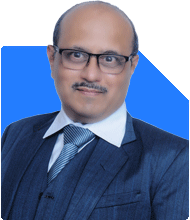44-Year-Old Assistant Professor with 14 Lakh Income - How to Invest?
Ramalingam Kalirajan |10870 Answers |Ask -Follow
Mutual Funds, Financial Planning Expert - Answered on Aug 12, 2024
He has an MBA in finance from the University of Madras and is a certified financial planner.
He is the director and chief financial planner at Holistic Investment, a Chennai-based firm that offers financial planning and wealth management advice.... more

hi i am working in govt university as assistant professor. my age is 44 years. my annual income 14 lakhs. i am invested only in real state through personal loan. emi 29000. no other investment has been done . i have two sons . pl suggest the investment plan for me
Your current investment strategy, focused solely on real estate, may not be the most effective approach for long-term financial growth and security. Diversification is key to ensuring a balanced and robust financial future.
Assessing Your Investment Goals
Before diving into specific investment options, it's essential to define your financial goals. These might include:
Building a Retirement Corpus: You should plan for a comfortable retirement, given your current age of 44 years. Ideally, you would want to retire with a significant corpus that can provide a steady income post-retirement.
Children’s Education: With two sons, planning for their higher education should be a priority. Education costs are rising, and it's wise to start investing early to meet these expenses without financial strain.
Emergency Fund: Having an emergency fund is crucial. It ensures you have immediate access to funds in case of unforeseen circumstances. Typically, an emergency fund should cover 6-12 months of living expenses.
Health and Life Insurance: Adequate health and life insurance coverage is necessary to protect your family in case of any unfortunate event. This ensures that your family’s financial future is secure.
Building a Diversified Investment Portfolio
Now that you have a clear understanding of your financial goals, let’s explore how to diversify your investment portfolio beyond real estate.
1. Systematic Investment in Mutual Funds
Mutual funds offer an excellent opportunity to grow your wealth over time. They provide diversification, professional management, and a range of options to suit different risk appetites.
Equity Mutual Funds: These funds invest in stocks and have the potential for higher returns over the long term. Given your age, you can consider a mix of large-cap, mid-cap, and multi-cap funds. These funds are ideal for long-term goals like retirement and children's education.
Debt Mutual Funds: These are safer options compared to equity funds and are suitable for short to medium-term goals. They invest in fixed-income securities and provide steady returns with lower risk. Consider allocating a portion of your investments to debt funds to balance risk.
Balanced Funds: These funds invest in both equities and debt instruments, offering a balance of growth and stability. They are suitable for investors looking for moderate risk with steady returns.
Why Choose Actively Managed Funds?
Avoid index funds as they simply track the market and do not provide the expertise of a fund manager. Actively managed funds, on the other hand, are managed by experts who aim to outperform the market. This approach can potentially provide better returns, especially in a fluctuating market.
2. Systematic Investment Plan (SIP)
A SIP is a disciplined way to invest regularly in mutual funds. It allows you to invest a fixed amount every month, regardless of market conditions. This strategy helps in rupee cost averaging and building a substantial corpus over time.
Given your EMI of Rs 29,000, it’s advisable to start with a SIP amount that you are comfortable with. Even a modest monthly investment can grow significantly over the years due to the power of compounding.
3. Public Provident Fund (PPF)
The PPF is a long-term savings scheme backed by the government, offering tax benefits and attractive interest rates. It is a risk-free investment option suitable for conservative investors. The PPF comes with a lock-in period of 15 years, making it ideal for building a retirement corpus or meeting long-term goals like your children’s education.
4. Term Insurance
As a responsible family person, securing your family's future is paramount. A term insurance policy provides a high life cover at an affordable premium. Ensure you have adequate term insurance that covers your family’s needs in case of your untimely demise. The coverage should be at least 10-15 times your annual income to provide sufficient financial security to your family.
5. Health Insurance
Given the rising healthcare costs, having adequate health insurance coverage is essential. Ensure you have a comprehensive health insurance policy that covers yourself and your family. You can opt for a family floater policy, which covers all members under a single plan. This will help you manage any unforeseen medical expenses without dipping into your savings.
6. Emergency Fund
If you don't already have one, start building an emergency fund immediately. This fund should be easily accessible and stored in a liquid instrument such as a savings account or liquid mutual fund. Aim to save 6-12 months of your living expenses, which will cover your family’s needs in case of emergencies like job loss or medical crises.
Steps to Implement Your Investment Plan
Now that we have discussed various investment options, here’s how you can implement this plan:
Step 1: Assess Your Monthly Budget: After accounting for your EMI, determine how much you can comfortably allocate towards investments.
Step 2: Start SIPs in Mutual Funds: Begin with a SIP in a balanced mutual fund. As you become comfortable, gradually increase the SIP amount and diversify into equity and debt funds.
Step 3: Open a PPF Account: Consider opening a PPF account and start contributing regularly. This will be part of your long-term savings plan.
Step 4: Purchase Adequate Insurance: Ensure you have both term and health insurance in place. Review your existing coverage and enhance it if necessary.
Step 5: Build an Emergency Fund: Gradually build an emergency fund by setting aside a fixed amount every month. Keep this fund liquid and accessible.
Step 6: Regularly Review Your Portfolio: Periodically review your investment portfolio to ensure it aligns with your financial goals. Adjust your investments if necessary, based on market conditions and your risk tolerance.
Final Insights
You have already taken the first step towards financial security by investing in real estate. However, relying solely on real estate is not enough to meet your long-term goals. Diversifying your portfolio with mutual funds, PPF, and insurance will provide a balanced approach to wealth creation and risk management.
By systematically investing in mutual funds through SIPs, you can build a substantial corpus for your retirement and your children’s education. Additionally, securing adequate term and health insurance will protect your family’s future.
Remember, it's never too late to start investing. By taking these steps, you will be on the right path to achieving your financial goals and securing a comfortable future for your family.
Best Regards,
K. Ramalingam, MBA, CFP,
Chief Financial Planner,
www.holisticinvestment.in
You may like to see similar questions and answers below
Hemant Bokil | Answer |Ask -Follow
Financial Planner - Answered on May 25, 2023
Ramalingam Kalirajan |10870 Answers |Ask -Follow
Mutual Funds, Financial Planning Expert - Answered on Jun 09, 2024
Ramalingam Kalirajan |10870 Answers |Ask -Follow
Mutual Funds, Financial Planning Expert - Answered on Feb 07, 2025
Ramalingam Kalirajan |10870 Answers |Ask -Follow
Mutual Funds, Financial Planning Expert - Answered on May 29, 2025
Nitin Narkhede | Answer |Ask -Follow
MF, PF Expert - Answered on May 25, 2025
Dr Shyam Jamalabad |106 Answers |Ask -Follow
Dentist - Answered on Dec 05, 2025
Dr Dipankar Dutta |1836 Answers |Ask -Follow
Tech Careers and Skill Development Expert - Answered on Dec 05, 2025
Ulhas Joshi |280 Answers |Ask -Follow
Mutual Fund Expert - Answered on Dec 05, 2025
Dr Dipankar Dutta |1836 Answers |Ask -Follow
Tech Careers and Skill Development Expert - Answered on Dec 04, 2025
Ravi Mittal |676 Answers |Ask -Follow
Dating, Relationships Expert - Answered on Dec 04, 2025
Anu Krishna |1745 Answers |Ask -Follow
Relationships Expert, Mind Coach - Answered on Dec 04, 2025
Anu Krishna |1745 Answers |Ask -Follow
Relationships Expert, Mind Coach - Answered on Dec 04, 2025
Mayank Chandel |2562 Answers |Ask -Follow
IIT-JEE, NEET-UG, SAT, CLAT, CA, CS Exam Expert - Answered on Dec 04, 2025
Mayank Chandel |2562 Answers |Ask -Follow
IIT-JEE, NEET-UG, SAT, CLAT, CA, CS Exam Expert - Answered on Dec 04, 2025
Mayank Chandel |2562 Answers |Ask -Follow
IIT-JEE, NEET-UG, SAT, CLAT, CA, CS Exam Expert - Answered on Dec 04, 2025










.jpg)


















